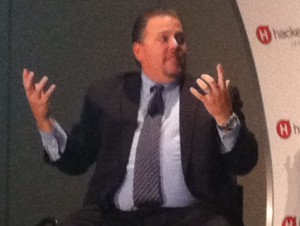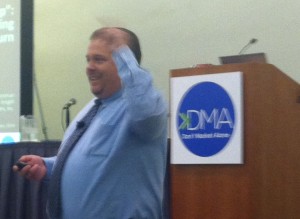
You can always tell when a person is enjoying himself – the bright eyes, the smiling face and the hand gestures are unmistakable. Jim Foreman from Staples is an executive that clearly enjoys talking about both marketing and analytics, which makes his presentations both informative and enjoyable.
Recently, Jim shared his perspectives about customer relationships by comparing them to personal relationships, and particularly how the right approach to a relationship can be useful in avoiding a breakup.
And like personal relationships, business relationships are fundamentally about people and how they relate, so his view is that the

possibility of a breakup in business follows the same patterns as what you find on a personal level, with two principal causes:
- Misaligned expectations
- Unmet needs.
Misaligned expectations:
Every relationship has expectations – customer expectations in a business setting can be such things as a clean environment, reasonably good assortment and decent prices.
The personal relationship equivalents relate to attention to appearance and good manners. These are always important, but especially in the early stages. The main point Jim makes, however, are that very few relationships are successful in the long-term if the majority of expectations are not met.
Expectations can get tricky once you realize that people may engage with your brand at different times in different personas. For Staples, you might have John Doe stop by to get back-to-school supplies, and then place an order to replenish the office cabinet later in the same day, and then search the Staples.com site a different time to check out seating options. Not all John Doe personas result directly in a sale and each persona might respond differently to the same offer.
It follows that knowing your customer is very important to knowing how to engage with them. And the larger your business or the more numerous your product set, the more complex that challenge becomes. Fortunately, there’s analytics to help sort it out.
Unmet needs:
Jim’s point here begins with the idea that people don’t stay the same forever. In order to succeed, both parties need to evolve and adapt to the changing needs of the other party. Here again, it’s analytics that helps businesses stay attuned to the changing needs of customers so they can anticipate them and meet them with the right offer at the right time.
Marketing has always been about getting the right offer in front of the right people at the right time. What’s changed is our operating environment and the tools we have to make it possible. For Staples, the potential for unmet needs is huge. They have about 24 million or so active customers online and they operate the third largest e-commerce site in the world (behind Amazon and Apple). Now, upwards of 25% of their online traffic is mobile, but the mobile proportion of their transactions coming from mobile remains in the low single-digits.
How do they avoid unmet needs? With analytically-driven marketing solutions, such as marketing automation. The power of the analytics is when it’s paired with skilled marketers that know to put as much effort into learning what the customer wants to hear as they put into focusing on how and when to deliver the best message to the customer. The ideal scenario to Staples is to find a customer with an emotional connection to the company, fells like “they really get me,” and then becomes a brand evangelist and tells others about how great Staples is.
As Jim sees it, his challenge is to figure out how to sort through all of the “noise” to:
- Better-align with customer expectations
- More deeply engage customers by evolving their relationships with them
- Demonstrate an ongoing understanding of customer needs and how to best fulfill them
- Reduce the likelihood of a break-up
- Proactively identify customers who may be on the path to a break-up
The approach Jim recommends is to use three types of analytics to avoid customer break-ups:
- Qualitative Analysis – to hear from customers themselves,
- Descriptive Analytics – to learn from past customer behaviors, and
- Predictive Analytics – to anticipate future behavior.
Other recommendations Jim has for analytically-driven marketers include:
- Long-lasting and fulfilling relationships happen when expectations and reality align. Don’t pretend to be something you’re not.
- Successful relationships evolve over time as needs and priorities change – never stop listening and responding.
- Scrutinize your best/longest relationships: mine your data to find characteristics that can be cultivated or used to acquire new customers with a higher likelihood of retention
- Invest time and money to preserve/enhance your best relationships, and don’t be afraid to walk away from the worst
- Customer data is a strategic asset: get analysts/data scientists involved early in the decision-making process so the benefits of customer data (and the many ways it can be used) can be baked-into strategies from the beginning!
Jim Foreman is Director of Analytics & Customer Insight at Staples Corp. He is a perennial favorite presenter at the DMA annual conference.
